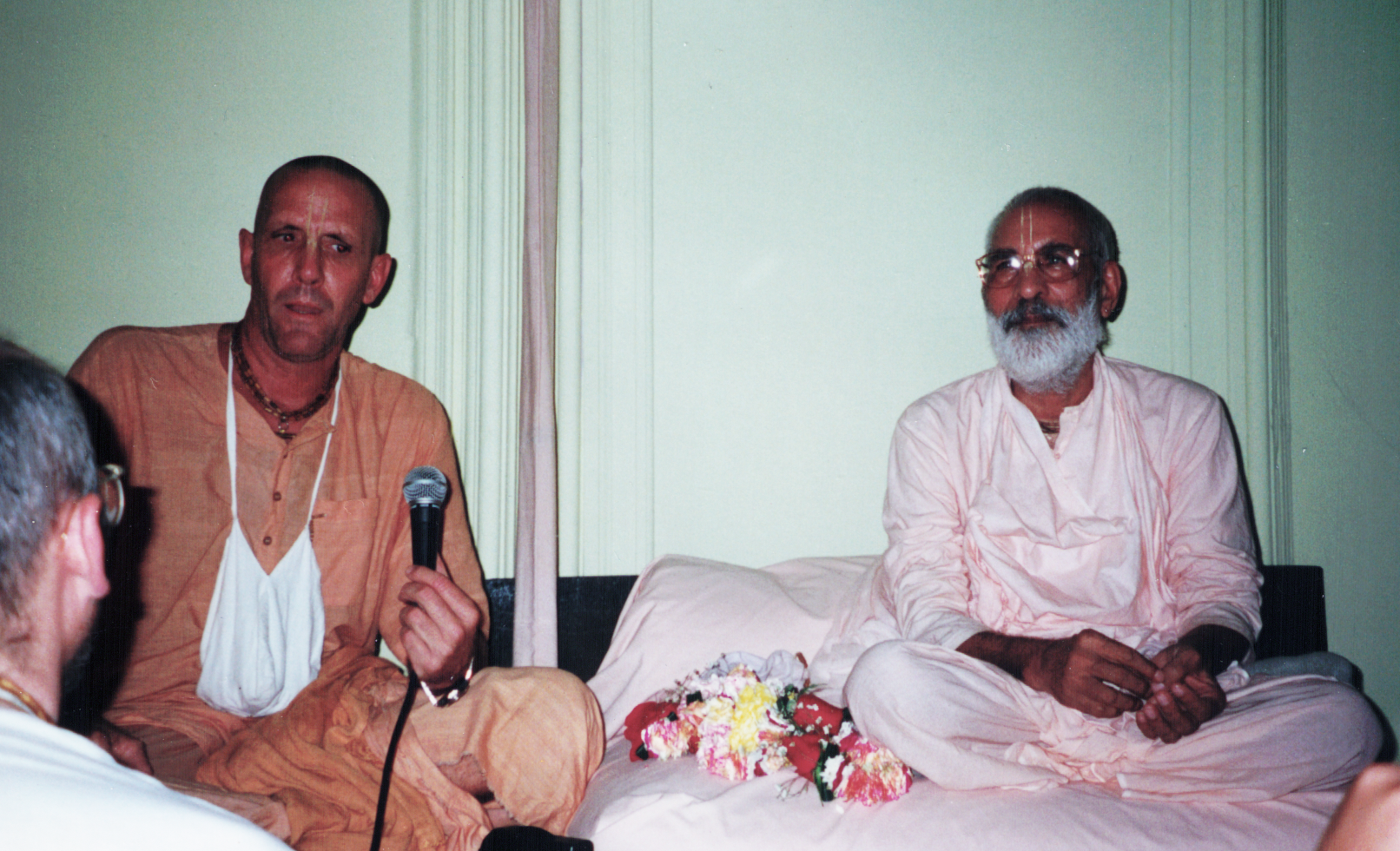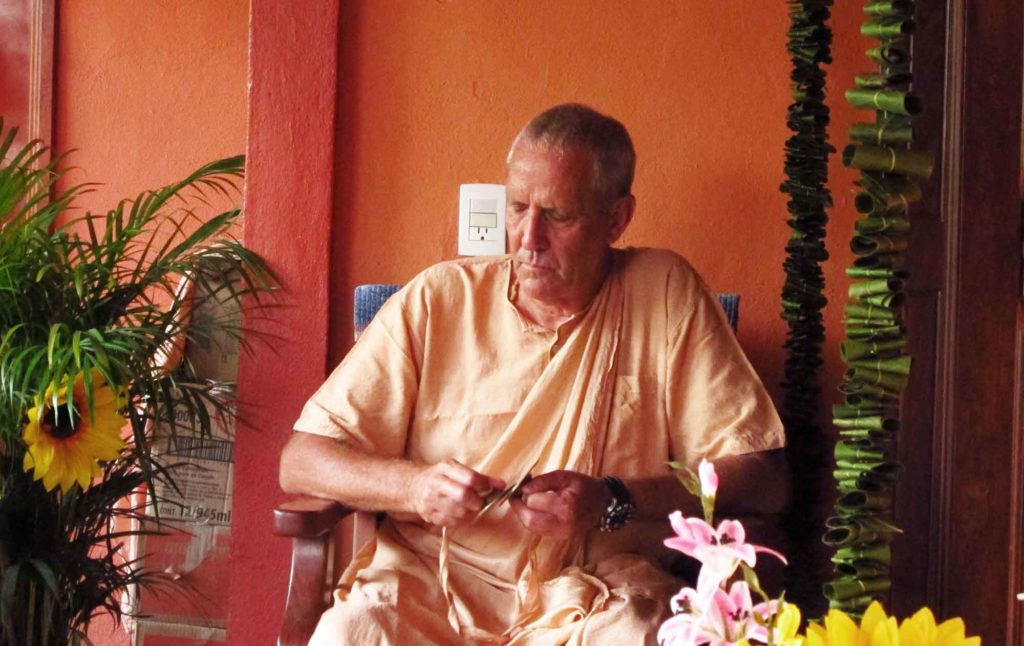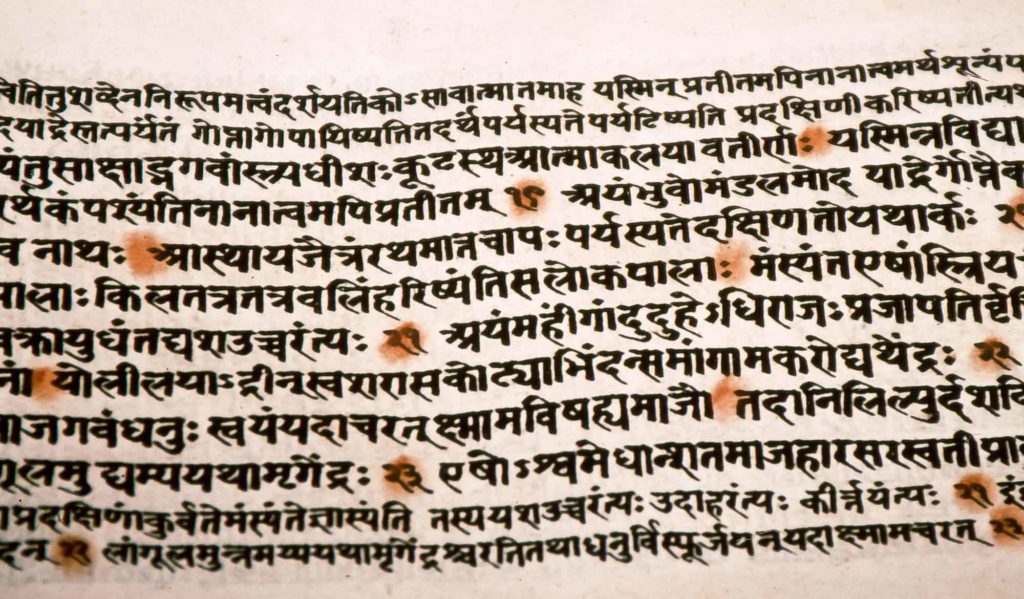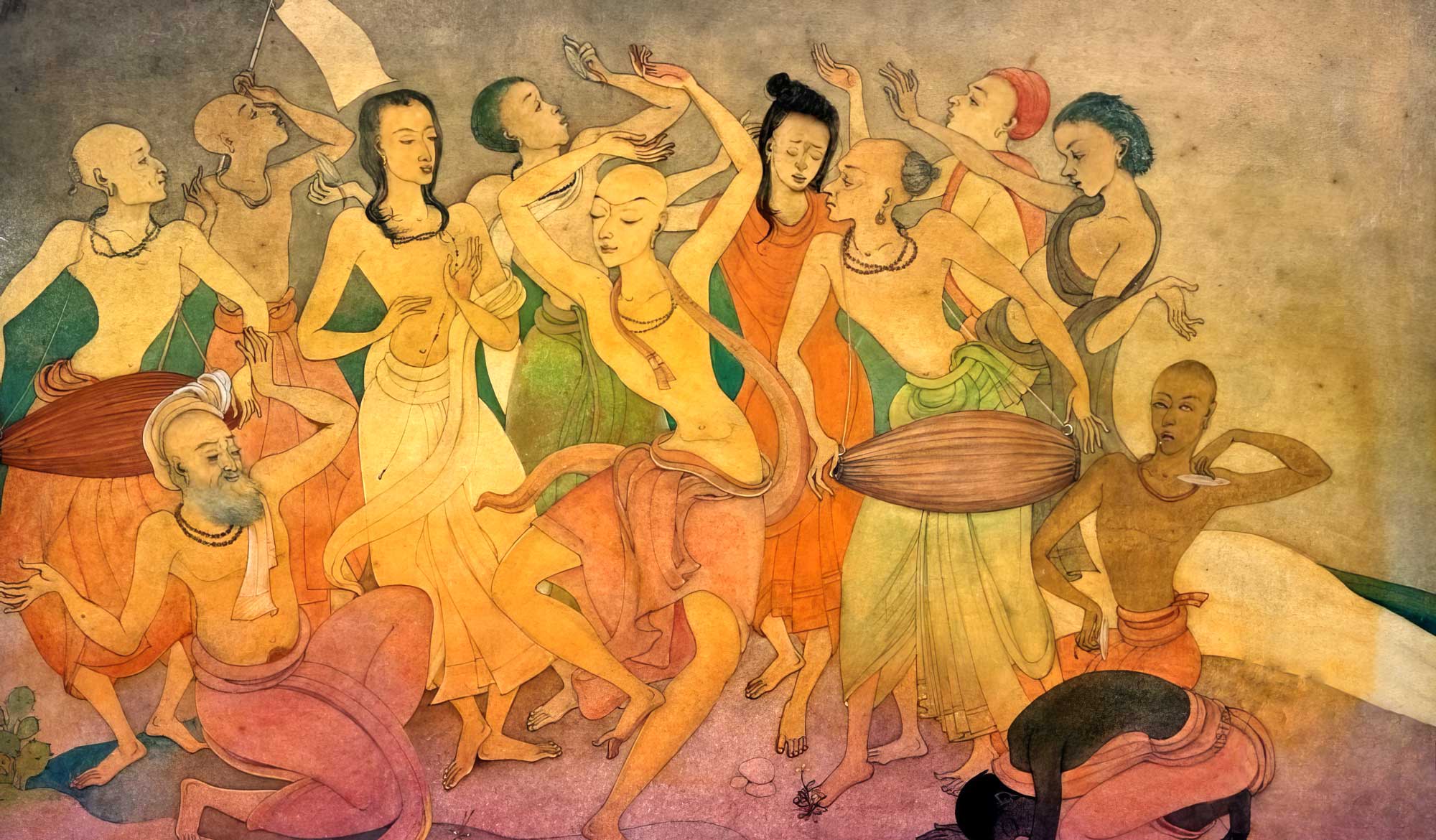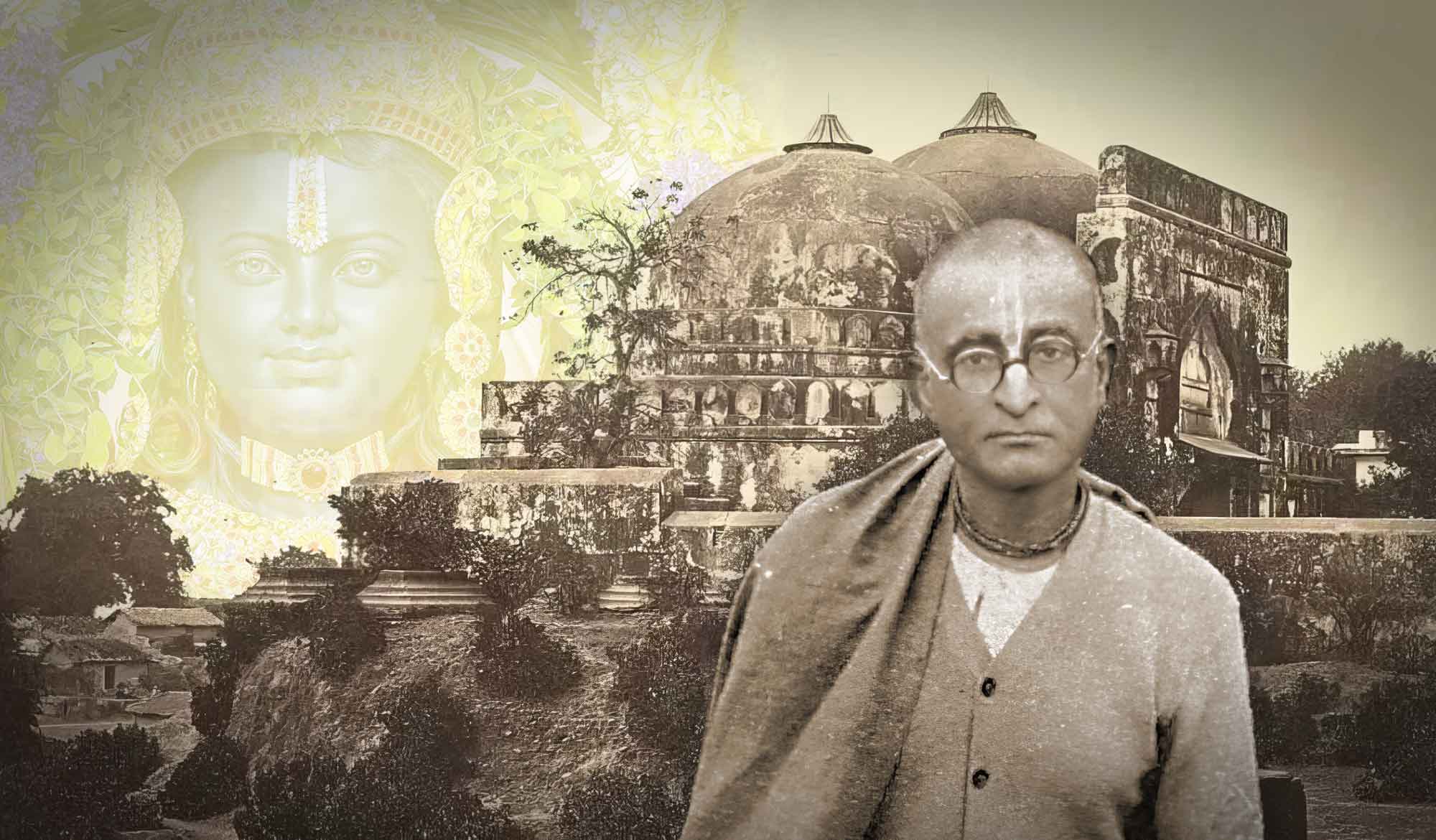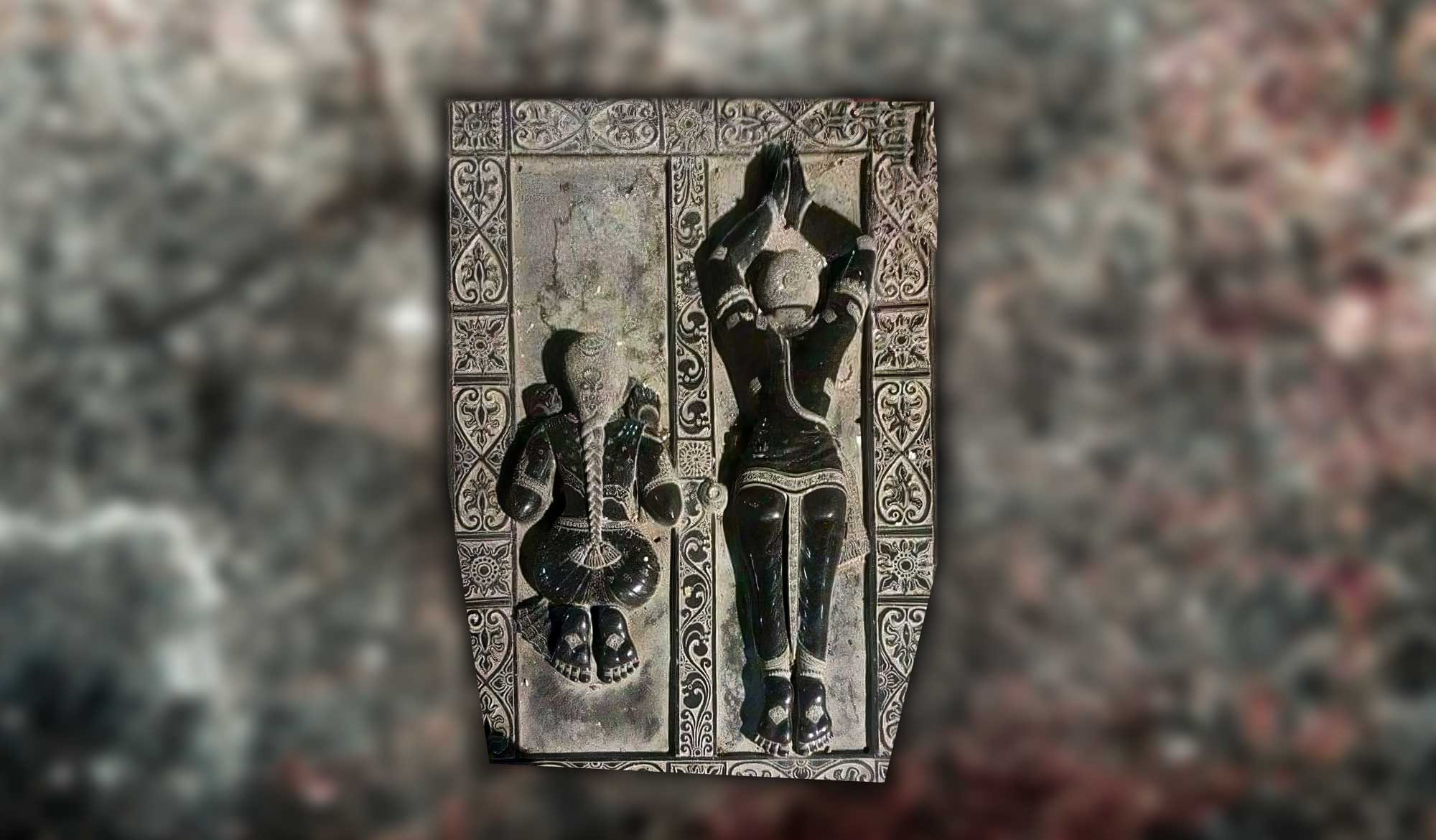Overview
“Ratha Yātrā in Navadvīpa” was written by Swami B.G. Narasingha on September 5th 2000. This article was in response to a statement by Śrīpāda B.V. Nārāyaṇa Mahārāja in relation to Śrīla Śrīdhara Deva Gosvāmī Mahārāja. Narasingha Maharaja gives a brief history of the unfortunate situation. This article was followed up by another called “A Brief Response to “Ratha Yātrā in Navadvīpa.”
“If someone is criticising one’s Gurudeva and the disciple remains quiet, then he is not more than an impotent eunuch.”
Question: I have taken the following clip (below) from a lecture of Swami B.V. Nārāyaṇa Mahārāja given on Baladeva Pūrṇimā of this year. There seems to be a lot involved in what Mahārāja is saying, but many things seem unclear. It appears that Nārāyaṇa Mahārāja is speaking about Śrīla Śrīdhara Mahārāja and stating that Śrīla Śrīdhara Mahārāja was criticising Śrīla Keśava Mahārāja. On the other hand, he (Nārāyaṇa Mahārāja) leads one to believe that he later defeated Śrīla Śrīdhara Mahārāja. Many of the devotees that I have spoken with are very disturbed about this matter and would like to hear your explanation and clarification on this topic. Could you please explain?
(Clip from Swami B.V. Nārāyaṇa Mahārāja: “If someone is criticising one’s Gurudeva and the disciple remains quiet, then he is not more than an impotent eunuch. When our Gurudeva started Ratha Yātrā in Navadvīpa, no one criticised him. When he left this world, however, a very highly advanced devotee spoke something against Ratha Yātrā in Navadvīpa. The day I heard it I could not sleep at night. I was restless and so much agitated. Soon after that I wrote an article in our magazine, and that article created chaos, havoc and very great agitation on the other side. Hence there was a fight, and that fight lasted for an entire year. If we do not do these things, we are not doing mano-bhiṣṭa sevā, service to the inner heart’s desire of Śrī Gurudeva. We should establish our Gurudeva’s principles and, when any opposition comes, we should defeat it.” (Hari-kathā, 2000 August 15th)
Answer: I am not able to give a glowing report on this subject and thus some devotees may not applaud what I have to say. Śrīpāda Nārāyaṇa Mahārāja has stated that if one criticises our Gurudeva we must come out and speak something in his defence. I agree whole heartily with that conception, yet I must add that one need not speak rudely when defending one’s guru, especially if one is speaking, as Śrīpāda Nārāyaṇa Mahārāja has indicated in his own words, to “a very highly advanced devotee.”
The first contention we have is whether or not Śrīla Keśava Mahārāja actually established the Ratha Yātrā in Navadvīpa in the first place. We do not find mention of such in the authorised biography of Śrīla Keśava Mahārāja nor did we hear of such from Śrīla Śrīdhara Mahārāja. It may have been so, but we are waiting to hear from a third party before making a final conclusion. Generally speaking, the programs established by Śrīla Keśava Mahārāja at the Devānanda Gauḍīya Maṭha, such as the Navadvīpa-dhāma parikramā have been maintained by the disciples of Śrīla Keśava Mahārāja, even up to the present day. There is, however, no Ratha Yātrā in Navadvīpa being maintained by that Maṭha.
There was of course Ratha Yātrā held by Devānanda Gauḍīya Maṭha sometime after the disappearance of Śrīla Keśava Mahārāja and that did, as stated by Nārāyaṇa Mahārāja, create quite a controversy, which led to chaos and havoc. As I have mentioned, it is doubtful that Śrīla Keśava Mahārāja established the Ratha Yātrā in Navadvīpa, but lastly if he did or if he didn’t, does not change the situation much.
Śrīla Śrīdhara Mahārāja advised that the Ratha Yātrā should not be held in Navadvīpa. His consideration was thus: Navadvīpa is the Gupta-Vṛndāvana (covered Vṛndāvana) and the ratha means the chariot. The chariot means Akrura, who has come to take Kṛṣṇa away from Vṛndāvana. Śrīla Śrīdhara Mahārāja stated that when the eternal residents of Navadvīpa-dhāma see the Ratha Yātrā, that it will strike terror in their hearts. Thus the Ratha Yātrā is not appropriate to be held in Navadvīpa-dhāma. Indeed, it would be an offence to the eternal inhabitants of the dhāma.
What Śrīla Śrīdhara Mahārāja has spoken in this regard is certainly a rasika consideration, one befitting his position as a very senior Vaisnava and it is certainly a consideration that any ‘rasikācārya’ should take very seriously. But in those days the disciples of Śrīla Keśava Mahārāja were quite young and they may have lacked the experience in dealing with very highly advanced devotees. So the disciples of Śrīla Keśava Mahārāja insisted on holding Ratha Yātrā, despite the opinion and request of Śrīla Śrīdhara Mahārāja.
To this Śrīla Śrīdhara Mahārāja replied that if they insist on holding Ratha Yātrā in Navadvīpa-dhāma then they should start the Ratha festival from the outskirts of Navadvīpa and bring the procession towards the Devānanda Gauḍīya Maṭha. In this way Śrīla Śrīdhara Mahārāja said that the eternal inhabitants of the dhāma would see the chariot as bringing Kṛṣṇa back to Vṛndāvana, this being a welcome sight. However, this suggestion of Śrīla Śrīdhara Mahārāja was also rejected and the disciples of Śrīla Keśava Mahārāja went ahead as planned.
This controversial issue was discussed through a series of articles that appeared in the journals of the Devānanda Gauḍīya Maṭha and the Śrī Caitanya Sārasvata Maṭha respectively. Nārāyaṇa Mahārāja was writing for Devānanda Gauḍīya Maṭha and Śrīla Damodara Mahārāja, a disciple of Saravwati Thakura was writing the articles on behalf of Śrīla Śrīdhara Mahārāja for Śrī Caitanya Sārasvata Maṭha. These articles were written in Bengali and those articles are still available in the respective maṭha libraries.
Ontologically, whatever Śrīla Śrīdhara Mahārāja directed to be written in the articles from his Maṭha was śāstricly correct and he did not at any time ‘criticise’ Śrīla Keśava Mahārāja as Nārāyaṇa Mahārāja has suggested. Criticism of another Vaisnava is something unknown in the life of Śrīla Śrīdhara Mahārāja, especially criticism of one as dear to him as his Godbrother, Śrīla Keśava Mahārāja.
The philosophical opinions presented by Śrīla Śrīdhara Mahārāja were unassailable. However, rather than accept a happy defeat and follow the advice of a ‘very highly advanced devotee,’ Nārāyaṇa Mahārāja, in a last effort to avoid surrender, turned to attacks on the character of Śrīla Śrīdhara Mahārāja and also to criticising Śrīla Śrīdhara Mahārāja’s competency to preach. In his last article Nārāyaṇa Mahārāja called Śrīla Śrīdhara Mahārāja ‘a fish seller and a coal merchant.’ Nārāyaṇa Mahārāja wrote, “You know the utility of selling fish and the utility of selling coal, but you do not know the utility of preaching.” * (see note at end of article)
Needless to say, such an attack on Śrīla Śrīdhara Mahārāja was completely uncalled for. One certainly has the right to preach what he earnestly believes to be the wishes of his Gurudeva and support such with philosophical arguments, but by name calling and ridiculing a senior Vaiṣṇava, certainly a great offence is committed. As Nārāyaṇa Mahārāja stated recently, “I wrote an article in our magazine, and that article created chaos, havoc and very great agitation on the other side.”
There were no more articles after that. Some devotees from the Śrī Caitanya Sārasvata Maṭha approached Devānanda Gauḍīya Maṭha and informed Nārāyaṇa Mahārāja that Śrīla Śrīdhara Mahārāja was mortified by Nārāyaṇa Mahārāja’s article. Śrīla Śrīdhara Mahārāja was so heartbroken by the words of Nārāyaṇa Mahārāja that he remained in a very serious and internal mood for three days and did not take prasādam, but remained fasting. This was intolerable for the disciples of Śrīla Śrīdhara Mahārāja, who then approached Nārāyaṇa Mahārāja and informed him of the gravity of the situation.
The next event to unfold was that Nārāyaṇa Mahārāja came to the holy lotus feet of Śrīla Śrīdhara Mahārāja with folded hands and humble prayers for forgiveness. True to the nature and character of Śrīla Śrīdhara Mahārāja he was very compassionate and kind-hearted to Nārāyaṇa Mahārāja when he came to beg for forgiveness. After hearing Nārāyaṇa Mahārāja speak, Śrīla Śrīdhara Mahārāja requested that if Nārāyaṇa Mahārāja actually felt that he had made an offence, that he should print a retraction to his previously published statements belittling Śrīla Śrīdhara Mahārāja. To this Nārāyaṇa Mahārāja agreed and returned to the Devānanda Gauḍīya Maṭha.
Unfortunately, the retraction by Nārāyaṇa Mahārāja was never published. From that day (sometime in 1974) until now, the members of the Devānanda Gauḍīya Maṭha and the members of the Śrī Caitanya Sārasvata Maṭha have never since embraced each other. Although separated by a distance of only one-kilometre, the members of these two Maṭhas do not visit each other. They do not attend the other’s programs and even at the time of the Navadvīpa-dhāma parikramā, held each year just before Gaura Pūrnīmā, the maṭhas do not pay even a complimentary visit to each other with their saṅkīrtana parties. Sad indeed.
It seems as though Nārāyaṇa Mahārāja was proudly boasting of the event of his having written the article against Śrīla Śrīdhara Mahārāja as though he had defeated an envious person, opposed to the principles of his Gurudeva. Was it actually such? Nārāyaṇa Mahārāja further assures his followers that if they do not follow in his footsteps and similarly defeat all opposing opinions of their Gurudeva then indeed they are no better than eunuchs. A peculiar yet appropriate analogy.
Another consideration that this issue raises is as follows: If Nārāyaṇa Mahārāja’s statements are to be taken at face value then what fault was there all these years for the leaders of ISKCON who attacked Nārāyaṇa Mahārāja when they felt that he was undermining and belittling Śrīla Prabhupada’s movement? Have they no right to defend the mission of their Gurudeva from direct attack? Yet, when doing so, Nārāyaṇa Mahārāja has repeatedly condemned them as Vaiṣṇava aparādhīs.
Only Nārāyaṇa Mahārāja has the right to defend his Gurudeva, all others should become eunuchs? Should it be such? But by Nārāyaṇa Mahārāja’s own admission the ISKCON leaders are now vindicated of whatever offences he has accused them of committing in the past.
Surely then, there should not be an outcry that I (Swami B.G. Narasingha) have become an offender to the ‘rasikācārya‘ simply because I have spoken out against the propaganda that Śrīla Śrīdhara Mahārāja waited until the disappearance of Śrīla Keśava Mahārāja to criticise the program of Ratha Yātrā in Navadvīpa-dhāma. Should I further stand silent while someone claims to have created chaos and havoc in the Maṭha of my śikṣā-guru? Lastly should I continue to stand silent while someone, who has grievously offended my Gurudeva and rejected the opinions of my Gurudeva, claims to be his śikṣā-disciple?
Is it not my duty to oppose such unfriendly elements, otherwise I too will be guilty of not doing mano-bhiṣṭa sevā, service to the inner heart’s desire of Śrī Gurudeva?
*End Note: At Śrī Caitanya Sārasvata Maṭha there is a large pond just in front of the main gate. It is the law in Bengal that if you do not fish your pond then you must allow others to do so, either for free or under contract. If you do not do this then the government of Bengal can seize your pond. Under the circumstances Śrīla Śrīdhara Mahārāja made a unique decision. Rather than allow the government of Bengal to appropriate the Deities property or the villagers to freely kill the fish, it would be of some benefit for the fish if the fishermen were to fish the pond under a contract with the maṭha. Thus the rupees received from the fishermen for the rights to fish the pond were directly engaged in the service of the Deity. It was also the practice of the maṭha to purchase a large amount of coal at one time and sell it to the surrounding villagers in small amounts day by day. Thus a modest profit was earned to help with the maintenance of the temple and maṭha.
Related Articles
- A Rūpānuga’s Constant Meditation Concerning Śrī Ratha Yātrā by Śrīla B.R. Śrīdhara Mahārāja
- Śrī Nimbāditya and Nimbārka Are Not the Same Person by Śrīla Bhakti Prajñāna Keśava Mahārāja
- Ratha Yātrā in Navadvīpa by Śrīla Bhakti Gaurava Narasiṅgha Mahārāja
- A Brief Response to Ratha Yatra in Navadvīpa by Śrīla Bhakti Gaurava Narasiṅgha Mahārāja
- Bhaktivedānta by Śrīla Bhakti Gaurava Narasiṅgha Mahārāja
- Śrīdhara Deva Gosvāmī by Śrīla Bhakti Gaurava Narasiṅgha Mahārāja
- Ativāḍī Apa-Sampradāya by Śrīla Bhakti Gaurava Narasiṅgha Mahārāja
- Hita Harivaṁśa and the Rādhā-Vallabha Sect by Swami B.V. Giri
- The Temple of Understanding by Śrīla Bhakti Gaurava Narasiṅgha Mahārāja
- Māyāpura and the Adbhūta Mandira by Śrīla Bhakti Gaurava Narasiṅgha Mahārāja
- The Adbhūta Mandira and Bhaktivinoda’s Vision by Śrīla Bhakti Gaurava Narasiṅgha Mahārāja
- Nimbārka and Keśava Kāśmīrī by Śrīla Bhakti Gaurava Narasiṅgha Mahārāja
- The Mystery of the History of the Līlā of Dāmodara by Śrīla Bhakti Gaurava Narasiṅgha Mahārāja
- Prabodhānanda and Prakāśānanda by Swami B.V. Giri
Further Reading
- A Discussion in Relation to the Dates of the Six Gosvāmīs by Śrīla Bhaktivinoda Ṭhākura
- Śrī Śrī Rūpa Gosvāmī Prabhu by Śrīla Bhaktivinoda Ṭhākura
- Śrī Śrī Sanātana Gosvāmī Prabhu by Śrīla Bhaktivinoda Ṭhākura
- Śrī Śrī Gopāla Bhaṭṭa Gosvāmī Prabhu by Śrīla Bhaktivinoda Ṭhākura
- Śrī Śrī Jīva Gosvāmī Prabhu by Śrīla Bhaktivinoda Ṭhākura
- Śrī Śrīnivāsa Ācārya Prabhu by Śrīla Bhaktivinoda Ṭhākura
- Śrī Śrī Kṛṣṇa Dāsa Kavirāja Gosvāmī Prabhu by Śrīla Bhaktivinoda Ṭhākura
- Śrī Śrī Prabhu Rāmacandra Gosvāmī by Śrīla Bhaktivinoda Ṭhākura
- Kavi Rāma Prasāda (The Poet Rāma Prasāda) by Śrīla Bhaktivinoda Ṭhākura
- Śrī Śrī Abhirāma Gosvāmī by Śrīla Bhaktivinoda Ṭhākura
- Śrī Parameśvarī Dāsa by Śrīla Bhaktivinoda Ṭhākura
- Śrī Jāhnavā Devī by Śrīla Bhaktivinoda Ṭhākura
- Salve for the Eyes of the Blind by Śrīla Bhaktivinoda Ṭhākura
- Śrī Bhāgavatācārya by Śrīla Bhaktivinoda Ṭhākura
- The Place of Śrīla Bhāgavatācārya by Śrīla Bhaktivinoda Ṭhākura
- The Inauguration of a Prapannāśrama in Amaljoda by Śrīla Bhaktivinoda Ṭhākura
- A Question and Answer Concerning Śrī Kṛṣṇa Saṁhitā (Praśnottara) by Śrīla Bhaktivinoda Ṭhākura
- An Earnest Appeal by Śrīla Bhaktivinoda Ṭhākura
- Śrī Śrī Hari Dāsa Ṭhākura’s Place in Kulīnagrāma by Śrīla Bhaktivinoda Ṭhākura
- The Place of Śrī Nakula Brahmacārī by Śrīla Bhaktivinoda Ṭhākura
- Śrīpāṭa Denuḍa by Śrīla Bhaktivinoda Ṭhākura
- Śrīdhāma Māyāpura by Śrīla Bhaktivinoda Ṭhākura
- Śrī Śyāmānanda Gosvāmī by Śrīla Bhaktivinoda Ṭhākura
- Śrī Māna Sarovara by Śrīla Bhaktivinoda Ṭhākura
- Gata-varṣa (The Last Year) by Śrīla Bhaktivinoda Ṭhākura
- The Temple of Śrī Śrī Jagannāthadeva by Śrīla Bhaktivinoda Ṭhākura
- Nāḍā by Śrīla Bhaktivinoda Ṭhākura
- The Instructions of Śrīmad Rāmānuja Svāmī – the Ācārya of the Śrī Sampradāya by Śrīla Bhaktivinoda Ṭhākura
- Śrīman Nimbāditya by Śrīla Bhaktivinoda Ṭhākura
- Śrī Acyutānanda’s Departure by Śrīla Bhaktivinoda Ṭhākura
- British Rule and the Vaiṣṇavas by Śrīla Bhaktivinoda Ṭhākura
- The Society of Śrī Gaurāṅga by Śrīla Bhaktivinoda Ṭhākura
- The Temple of Jagannath at Puri by Śrīla Bhaktivinoda Ṭhākura
- A Review of the Previous Year by Śrīla Bhaktivinoda Ṭhākura
- Prabodhānanda and Prakāśānanda by Śrīla Bhaktivinoda Ṭhākura
- Rādhā-kuṇḍa and Śyāma-kuṇḍa by Śrīla Bhaktivinoda Ṭhākura
- Puratana Gañja of Śrīdhāma Navadvīpa by Śrīla Bhaktivinoda Ṭhākura
- What Has Happened in Śrī Māyāpura? by Śrīla Bhaktivinoda Ṭhākura
Pilgrimage with Swami Narasiṅgha – Part 7: Keśī Ghāṭa
Continuing with our pilgrimage series, this week Śrīla Narasiṅgha Mahārāja takes us to Keśī Ghāṭā where he tells us about Madhumaṅgala’s meeting with the Keśī demon, what Keśī represents, and how Śrīla Prabhupāda almost acquired Keśī Ghāṭa. Mahārāja also narrates his own experience. This article has been adapted from a number of talks and articles by Narasiṅgha Mahārāja.
Prema Dhāma Deva Stotram with the Narasiṅgha Sevaka Commentary – Verses 61-65
In verses 61 to 65 of 'Prema Dhāma Deva Stotram', Śrīla Śrīdhara Mahārāja narrates the pastime of Śrī Caitanya at Caṭaka Parvata In Purī and explains how the scriptures produced by Brahmā and Śiva are ultimately searching for the personality of Mahāprabhu who is merciful too all jīvas, no matter what their social position.
Prabhupāda Śrīla Sarasvatī Ṭhākura’s Visit to Ayodhyā
With the forthcoming observance of Śrī Rāma Navamī, we present 'Prabhupāda Śrīla Sarasvatī Ṭhākura’s Visit to Ayodhyā' written by Śrīla Bhaktisiddhānta Sarasvatī Ṭhākura Prabhupāda from The Gaudīyā magazine, Vol 3. Issue 21/ In December 1924, after visiting Benares and Prāyāga, Sarasvatī Ṭhākura visited the birth-site of Śrī Rāmācandra in Ayodhyā.
Śaraṇāgati – The Only Path to Auspiciousness
In this article, 'Śaraṇāgati - The Only Path to Auspiciousness', Dhīra Lalitā Dāsī analyses the process of śaraṇāgati (surrender) beginning with śraddhā (faith). She also discusses the role of śāstra and the Vaiṣṇava in connection with surrender.
Pilgrimage with Swami Narasiṅgha – Part 7: Keśī Ghāṭa
Continuing with our pilgrimage series, this week Śrīla Narasiṅgha Mahārāja takes us to Keśī Ghāṭā where he tells us about Madhumaṅgala’s meeting with the Keśī demon, what Keśī represents, and how Śrīla Prabhupāda almost acquired Keśī Ghāṭa. Mahārāja also narrates his own experience. This article has been adapted from a number of talks and articles by Narasiṅgha Mahārāja.
Prema Dhāma Deva Stotram with the Narasiṅgha Sevaka Commentary – Verses 61-65
In verses 61 to 65 of 'Prema Dhāma Deva Stotram', Śrīla Śrīdhara Mahārāja narrates the pastime of Śrī Caitanya at Caṭaka Parvata In Purī and explains how the scriptures produced by Brahmā and Śiva are ultimately searching for the personality of Mahāprabhu who is merciful too all jīvas, no matter what their social position.
Prabhupāda Śrīla Sarasvatī Ṭhākura’s Visit to Ayodhyā
With the forthcoming observance of Śrī Rāma Navamī, we present 'Prabhupāda Śrīla Sarasvatī Ṭhākura’s Visit to Ayodhyā' written by Śrīla Bhaktisiddhānta Sarasvatī Ṭhākura Prabhupāda from The Gaudīyā magazine, Vol 3. Issue 21/ In December 1924, after visiting Benares and Prāyāga, Sarasvatī Ṭhākura visited the birth-site of Śrī Rāmācandra in Ayodhyā.
Śaraṇāgati – The Only Path to Auspiciousness
In this article, 'Śaraṇāgati - The Only Path to Auspiciousness', Dhīra Lalitā Dāsī analyses the process of śaraṇāgati (surrender) beginning with śraddhā (faith). She also discusses the role of śāstra and the Vaiṣṇava in connection with surrender.


